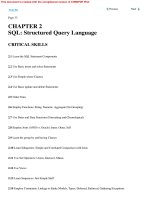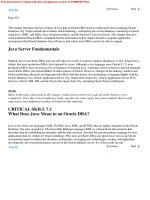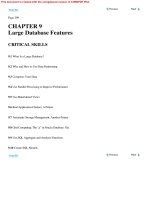oracle 8 database administration volume 1 instruction guide phần 2 potx
Bạn đang xem bản rút gọn của tài liệu. Xem và tải ngay bản đầy đủ của tài liệu tại đây (794.59 KB, 40 trang )
Oracle8: Database Administration 1-13
.
Connecting to a Database
Apart from the database files, an Oracle server also uses other files. Some of
these are:
• Parameter file: used to define the characteristics of an Oracle instance
• Password file: used to authenticate privileged database users
• Archived redo log files: offline copies of the redo log files that may be
necessary to recover from media failures
The following sections of this lesson explain how a server process uses some
of the components of the Oracle instance and the database to service
requests made by a user process.
1-9
Copyright Oracle Corporation, 1998. All rights reserved.
Database
Other Key Physical Structures
Archived
log files
Password
file
Parameter
file
1-14 Oracle8: Database Administration
.
Lesson 1: Oracle Architectural Components
Running a Query
The following are the main stages in the processing of a query:
1 Parse: In this stage, the user process sends the query to the server process
with a request to parse or compile the query. The server process checks
the validity of the command and uses the area in the SGA known as the
shared pool to compile the statement. At the end of this phase, the server
process returns the status—that is, success or failure of the parse
phase—to the user process.
2 Execute: During this phase in the processing of a query, the server
process prepares to retrieve the data.
3 Fetch: The rows that are retrieved by the query are returned by the server
to the user during this phase. Depending on the amount of memory used
for the transfer, one or more fetches are required to transfer the results of
a query to the user.
Instructor Note
This slide has a build. There are three stages.
1-10
Copyright Oracle Corporation, 1998. All rights reserved.
User
process
Server
process
Processing a Query
Parse
Statement
OK
Handle
Execute
OK
Handle
Fetch
Results
SELECT *
FROM emp
ORDER BY ename;
Oracle8: Database Administration 1-15
.
Running a Query
The shared pool is a part of the SGA that is used during the parse phase. The
size of the shared pool is specified by the initialization parameter,
SHARED_POOL_SIZE in the parameter file. The components of the shared
pool described below are used to parse an SQL statement.
Library Cache
The library cache stores the following information about the most recently
used SQL statements:
• Text of the statement
• Parse tree, which is the compiled version of the statement
• Execution plan, which defines the steps to be followed in running the
statement as determined by the optimizer
Since the library cache stores this information, if a query is reexecuted
before its execution plan is aged out by other statements, the server process
does not need to parse the statement. Thus the library cache helps improve
the performance of applications.
1-11
Cop
y
ri
g
ht Oracle Corporation
,
1998. All ri
g
hts reserved.
The Shared Pool
• Size defined by SHARED_POOL_SIZE
• Library cache contains statement text,
parsed code, and an execution plan
• Data dictionary cache contains table
and column definitions and privileges
Shared pool
Library
cache
Data
dictionary
cache
1-16 Oracle8: Database Administration
.
Lesson 1: Oracle Architectural Components
Data Dictionary Cache
The data dictionary cache, also known as the dictionary cache or row cache,
is a part of the shared pool that stores the most recently used data dictionary
information, such as table and column definitions, usernames, passwords,
and privileges.
During the parse phase, the server process looks for the information in the
dictionary cache to resolve the object names specified in the SQL statement
and to validate the access privileges. If necessary, the server process initiates
the loading of this information from the data files.
Oracle8: Database Administration 1-17
.
Running a Query
When a query is processed, the server process looks for the blocks needed in
the database buffer cache. If the block is not found in the database buffer
cache, the server process reads the block from the data file and places a copy
in the buffer cache. Subsequent requests for the same block are likely to find
the block in memory, and may not require physical reads.
Function of the Database Buffer Cache
The database buffer cache, or simply the buffer cache, is an area in the SGA
that is used to store the most recently used data blocks. The size of each
buffer in the buffer cache is equal to the size of a data block, and it is
specified by the DB_BLOCK_SIZE parameter. The number of buffers is
equal to the value of the DB_BLOCK_BUFFERS parameter. The Oracle
server uses a least recently used (LRU) algorithm to age out buffers that
have not been accessed recently to make way for new blocks to be
accommodated in the buffer cache.
1
-
12
Co
p
yright Oracle Cor
p
oration 1998 All rights reserved
Database Buffer Cache
• Number of buffers defined by
DB_BLOCK_BUFFERS
• Size of a buffer based on DB_BLOCK_SIZE
• Stores the most recently used blocks
1-18 Oracle8: Database Administration
.
Lesson 1: Oracle Architectural Components
The Program Global Area (PGA) is a memory region that contains data and
controls information for a single server process or a single background
process. In contrast to the SGA, which is shared and written to by several
processes, the PGA, which is also called the process global area, is an area
that is used by only one process. When using the dedicated server
configuration, the PGA contains:
• Sort area: which is used for any sort that may be necessary before rows
are processed or returned to the user
• Session information: such as user privileges for the session
• Cursor state: which indicates the stage in the processing of various
cursors that are currently used by the session
• Stack space: containing the session variables
The PGA is allocated when a process is created and deallocated when the
process is terminated.
Note
Some of these structures are stored in the SGA when using an MTS
configuration.
1-13
Copyright Oracle Corporation, 1998. All rights reserved.
Program Global Area (PGA)
• Not shared and not writable
• Contains
– Sort area
– Session information
– Cursor state
– Stack space
PGA
Server
process
Oracle8: Database Administration 1-19
.
Running a DML Statement
Running a DML Statement
A data manipulation language (DML) statement requires two phases of
processing:
• Parse, which is similar to the parse phase used for processing a query
• Execute
Execute Phase
Consider an example in which a user executes an update command of the
following form:
UPDATE emp
SET sal=sal*1.1
WHERE empno=7369;
What follows are the steps used in executing the update statement:
1 The server process reads the data and rollback blocks from the data files,
if they are not already in the buffer cache.
2 Copies of the blocks that are read are placed in the buffer cache.
3 The server process places locks on the data.
1-14
Copyright Oracle Corporation, 1998. All rights reserved.
Instance
SGA
Shared pool
Library
cache
Redo log
buffer
Database
buffer
cache
Data
dictionary
cache
UPDATE emp
SET sal=sal*1.1
WHERE empno=7369
Processing a DML Statement
1
Server
process
Control
files
Redo log
files
Data files
Database
2
3
4
5
1-20 Oracle8: Database Administration
.
Lesson 1: Oracle Architectural Components
4 The server process records the changes to be made to the rollback
(before-image) and to the data (new value) in the redo log buffer.
5 The server process records the before-image to the rollback block and
updates the data block, both in the database buffer cache. Both the
changed blocks in the buffer cache are marked as dirty buffers—that is,
buffers that are not the same as the corresponding blocks on the disk.
Note
The processing of a DELETE or INSERT command uses similar steps. The
before-image for a delete contains the column values in the deleted row,
while inserts just require the row location information to be stored in the
rollback.
Instructor Note
• The slide explaining the processing of a DML command has builds.
There are five stages.
• You may want to ask the students what the DML commands are. In the
current context we are referring to only the INSERT, UPDATE, and
DELETE commands.
Oracle8: Database Administration 1-21
.
Running a DML Statement
Before making a change, the server process saves the old value into a
rollback segment. This image is used to:
• Undo the changes if the transaction is rolled back
• Ensure that other transactions do not see uncommitted changes made by
the DML statement (read consistency)
• Recover the database to a consistent state in case of failures
Rollback segments, like tables and indexes, exist in data files and parts of
them are brought into the database buffer cache when required.
1-15
Copyright Oracle Corporation, 1998. All rights reserved.
Rollback Segment
DML
statement
Old
image
New
image
Rollback
segment
Table
1-22 Oracle8: Database Administration
.
Lesson 1: Oracle Architectural Components
The server process records changes made by an instance in the redo log
buffer, which is a part of the SGA. The redo log buffer has the following
characteristics:
• Its size in bytes is defined by the LOG_BUFFER parameter.
• It stores redo records, which record changes—that is, the block that is
changed, the location of the change, and the new value. A redo entry
registers a change, but it makes no distinction between the type of block
that is changed. So it cannot distinguish, for example, a change to a data
block from a change to an index or a rollback block.
• The redo log buffer is used sequentially, and changes made by one
transaction may be interleaved with changes made by other transactions.
• It is a circular buffer that is reused after it is filled up, but only after all
the old redo entries are recorded in the redo log files.
Note
The redo log files are covered in more detail in the lesson “Maintaining
Redo Log Files.”
1-16
Copyright Oracle Corporation, 1998. All rights reserved.
Redo Log Buffer
• Size defined by LOG_BUFFER
• Records changes made through the
instance
• Used sequentially
• Circular buffer
Oracle8: Database Administration 1-23
.
Running a DML Statement
The server process records changes to rollback and data blocks in the buffer
cache. The database writer (DBWR) writes the dirty buffers from the
database buffer cache to the data files. It ensures that sufficient number of
free buffers—buffers that can be overwritten when server processes need to
read in blocks from the data files—are available in the database buffer cache.
Database performance is improved because server processes only make
changes in the buffer cache, and the DBWR defers writing to the
data files until one of the following events occur:
• The number of dirty buffers reaches a threshold value
• A process scans a specified number of blocks when scanning for free
buffers and cannot find any
• A timeout occurs
• A DBWR checkpoint can be triggered by various events such as closing
of the database, (Checkpoint is a means of synchronizing the database
buffer cache with the data file.)
Note
Checkpoints are covered in detail in the lesson “Managing Redo Log Files.”
1-17
Copyright Oracle Corporation, 1998. All rights reserved.
Instance
SGA
Shared pool
DBWR
Database
buffer
cache
Database Writer (DBWR)
Control
files
Redo log
files
Data files
1-24 Oracle8: Database Administration
.
Lesson 1: Oracle Architectural Components
The Log Writer (LGWR) is a background process that writes entries from the
redo log buffer into the redo log files. The LGWR performs sequential
writes to the redo log file under the following situations:
• When the redo log buffer is one-third full
• When a timeout occurs (every three seconds)
• Before DBWR writes modified blocks in the database buffer cache to the
data files
• When a transaction commits
Instructor Note
You may want to inform the students that although there is a timeout, on a
busy OLTP system, this may never occur because other events may occur
more frequently.
1-18
Copyright Oracle Corporation, 1998. All rights reserved.
Instance
SGA
Shared pool
Redo log
buffer
LGWR
Log Writer (LGWR)
Control
files
Redo log
files
Data files
Oracle8: Database Administration 1-25
.
COMMIT Processing
COMMIT Processing
Oracle uses a fast commit mechanism that guarantees that the committed
changes can be recovered in case of failures.
System Change Number
Whenever a transaction commits, the Oracle server assigns a commit System
Change Number (SCN) to the transaction, which is monotonically
incremented and is unique within the database. The SCN is used by the
Oracle server as an internal “time stamp” to synchronize data and to provide
read consistency when data is retrieved from the data files. Using the SCN
allows the Oracle server to perform consistency checks without depending
on the date and time of the operating system.
Steps in Processing COMMITs
When a COMMIT is issued, the following steps occur:
1 The server process places a commit record, along with the SCN, in the
redo log buffer.
2 LGWR performs a contiguous write of all the redo log buffer entries up
to and including the commit record to the redo log files. After this point,
the Oracle server can guarantee that the changes will not be lost even in
case of failures.
3 The user is informed that the COMMIT is complete.
1-19
Copyright Oracle Corporation, 1998. All rights reserved.
Shared pool
Redo log
buffer
LGWR
Control
files
Redo log
files
Data files
Database
COMMIT Processing
Server
process
1
2
User
process
3
Database
buffer
cache
4
SGA
Instance
1-26 Oracle8: Database Administration
.
Lesson 1: Oracle Architectural Components
4 The server process records information to indicate that the transaction is
complete and that resource locks can be released.
Flushing of the dirty buffers to the datafile is performed independently by
DBWR, and can take place either before or after the commit.
Note
Rolling back a transaction does not trigger LGWR to write to disk. The
Oracle server always rolls back uncommitted changes when recovering from
failures. If there is a failure after a rollback, before the rollback entries are
recorded on disk, the absence of a commit record is sufficient to ensure that
the changes made by the transaction are rolled back.
Advantages of the Fast COMMIT
The use of these steps for processing COMMITs has the following
advantages:
• Sequential writes to the log files are faster than writing to different
blocks in the data file.
• Only minimal information that is necessary to record changes are written
to the log files, whereas writing to the data files would require whole
blocks of data to be written.
• The database COMMIT piggybacks redo log records from multiple
transactions requesting to commit at the same time into a single write.
• Unless the redo log buffer is particularly full, only one synchronous
write is required per transaction (can be less than one synchronous write
per transaction).
• The size of the transaction does not affect the amount of time needed for
an actual COMMIT operation.
Instructor Note
• Even though LGWR may write through the operating system buffer
cache, synchronous writes are used to ensure that confirmation of a
commit is only made after data is written to disk.
• The COMMIT processing slide has builds. There are four stages.
Oracle8: Database Administration 1-27
.
Summary
Summary
Instructor Note
• Lessons have a summary showing the following:
- A summary slide highlighting the most important objectives for the
lesson
- A Quick Reference listing the initialization parameters, commands,
and packages discussed in the lesson
• You may want to ask the students how users specify the database they
want to connect to, and emphasize the terms instance and database.
1-20
Copyright Oracle Corporation, 1998. All rights reserved.
Instance
SGA
Shared pool
DBWR LGWR
Database
Control
files
Data files
Redo log
files
User
process
Server
process
PGA
Summary
Password
file
Archived
log files
Parameter
file
1-28 Oracle8: Database Administration
.
Lesson 1: Oracle Architectural Components
Quick Reference
Context Reference
Processes User process
Server process
Background processes:
- DBWR
- LGWR
Memory structures SGA:
- Shared pool
- Database buffer cache
- Redo log buffer
PGA
Physical structures (files) Database files:
- Data files
- Control files
- Redo log files
Other files:
- Parameter file
- Password file
- Archived redo log files
Parameters SHARED_POOL_SIZE
DB_BLOCK_SIZE
DB_BLOCK_BUFFERS
LOG_BUFFER
2
Using Administration
Tools
2-2 Oracle8: Database Administration
.
Lesson 2: Using Administration Tools
Instructor Note
Topic Timing
Lecture 60 minutes
Practice 30 minutes
Total 90 minutes
Oracle8: Database Administration 2-3
.
Objectives
Objectives
Instructor Note
The purpose of this lesson is to ensure that participants get acquainted with
the use of the following tools:
• Server Manager Line Mode
• Oracle Enterprise Manager
It is not intended to provide details of all the components of OEM.
2-2
Copyright Oracle Corporation, 1998. All rights reserved.
Objectives
• Using the Server Manager Line Mode
• Identifying administration applications
supplied with the Oracle Enterprise
Manager
• Using Oracle Enterprise Manager
components
2-4 Oracle8: Database Administration
.
Lesson 2: Using Administration Tools
Overview
The table lists the common database administration tools and tasks that a
database administrator can perform using the tools.
These tools will be covered in this course, but they are only a subset of the
utilities supplied by Oracle. The commands for starting up the different tools
depend on the platform.
This lesson will introduce the use of the following tools that assist a DBA in
performing administrative tasks:
• Server Manager line mode
• Oracle Enterprise Manager
Note
In addition to these tools, NT-specific utilities like ORADIM80 or Oracle
Database Assistant for creation of an Oracle database will be covered in the
lessons “Managing an Oracle Instance” and “Creating a Database.”
2-3
Copyright Oracle Corporation, 1998. All rights reserved.
Tool
Server Manager Line
Mode
Oracle Enterprise
Manager
SQL*Loader
Export or Import utility
Password File utility
Description
A line mode utility used for
administrative tasks like
starting up, shutting down or
recovering a database
Graphical user interface to
administer, monitor, and tune
multiple databases.
Utility for loading data from
external files into Oracle tables
Utility for exporting/importing
data in Oracle format
Utility for creating database
password file
Database Administration
Tools: Examples
Oracle8: Database Administration 2-5
.
Using the Server Manager
Using the Server Manager
Server Manager line mode is useful for performing unattended operations,
such as running nightly batch jobs or scripts. In addition, you can use line
mode when a graphical interface is unavailable.
Starting Server Manager in Line Mode
Start Server Manager in line mode by entering the appropriate command at
the operating system prompt. For example, on some systems the command
svrmgrl starts up Server Manager in line mode.
You can also start Server Manager in line mode and execute a script.
Note
The exact command for starting Server Manager in line mode depends on
your platform. For information about starting Server Manager in line mode,
see your operating system
–specific Oracle documentation.
2-4
Copyright Oracle Corporation, 1998. All rights reserved.
Starting Server Manager in
Line Mode
On UNIX
svrmgrl
Starting and executing a script:
svrmgrl command=@credb.sql
svrmgrl command=“CONNECT scott/tiger”
svrmgr30
On NT
svrmgr30 command=@u16run.sql
On UNIX
On NT
2-6 Oracle8: Database Administration
.
Lesson 2: Using Administration Tools
Using Server Manager in Line Mode
Use the line mode to execute the Server Manager commands described in
the following section. In addition, you can execute SQL statements and
PL/SQL code.
Entering Server Manager Commands
Single-line Server Manager commands do not require punctuation or
terminators. A Server Manager command may span more than one line if
you use a backslash (\) at the end of each line to indicate a continuation.
SVRMGR> DESCRIBE \
2> scott.emp
Entering SQL or PL/SQL Code
You can enter single-line or multiple-line SQL statements in line mode.
Continuation characters are not needed in multiple-line SQL statements. To
end a SQL statement and execute it, either type a semicolon (;) at the end of
the statement, or type a slash (/) by itself on the last input line.
To execute PL/SQL code, type a slash (/) by itself on the last input line.
Running Scripts
In line mode, you can run scripts using the @ command. For example, to run
the script credb.sql, issue the statement @CREDB. If you do not specify a
script name, Server Manager prompts you for one.
Oracle8: Database Administration 2-7
.
Using the Server Manager
2-5
Copyright Oracle Corporation, 1998. All rights reserved.
Category
Command that do not need
database connection
Commands needing Oracle
privileges
Commands needing special
Oracle privileges
Server Manager Commands
Commands
EXIT
REMARK
SET
SHOW
SPOOL
CONNECT/DISCONNECT
DESCRIBE
EXECUTE
SHOW ERRORS
SHOW PARAMETER SHOW
SGA
CONNECT… AS SYSDBA
CONNECT… AS SYSOPER
ARCHIVE LOG
RECOVER DATABASE
STARTUP/SHUTDOWN
2-6
Copyright Oracle Corporation, 1998. All rights reserved.
Server Manager
Commands: Examples
SET CHARWIDTH 20
SET NUMWIDTH 8
SHOW ALL
SPOOL credb.log
SHOW SPOOL
Set the column display width
for character or numeric data:
Spool output to a file:
Display current settings:
2-8 Oracle8: Database Administration
.
Lesson 2: Using Administration Tools
Server Manager Commands
The table describes the most important Server Manager commands available in
line mode. These commands can also be used in the Oracle Enterprise Manager
worksheet.
Command Description
EXIT Exits Server Manager line mode or closes a SQL Worksheet
REMARK Enters a comment, typically in SQL script files
SET Sets or changes characteristics of the current command line mode
session
SHOW Shows settings currently in effect
SPOOL Enables or disables spooling of output to a specified file
CONNECT/
DISCONNECT
Connects to or disconnects from a database
DESCRIBE Describes a function, package, package body, procedure, table,
object, or view
EXECUTE Executes a one-line PL/SQL statement
SHOW
ERRORS
Shows the errors generated from the last compilation of a procedure,
package, or function
SHOW
PARAMETER
Displays the current values for one or more initialization parameters
SHOW SGA Displays information about the SGA of the current instance
CONNECT/AS
SYSDBA
Enables privileged connection to the database
ARCHIVE
LOG
Starts or stops automatic archiving of online redo log files, manually
archives specified redo log files, or displays information about redo
log files
RECOVER
DATABASE
Performs media recovery on one or more tablespaces, one or more,
or the entire database
STARTUP/
SHUTDOWN
Starts up or shuts down a currently running Oracle instance
Oracle8: Database Administration 2-9
.
Oracle Enterprise Manager
Oracle Enterprise Manager
Oracle Enterprise Manager (OEM) consists of a centralized console,
intelligent agents, and a package of standard applications that provide
database administrators the functionality they need to manage their
databases.
There is also a separately licensable package of integrated applications,
known as the OEM Performance Pack, that provides expert and advanced
monitoring, diagnostic, and tuning capabilities.
The OEM Console is currently available for Windows NT and Windows 95.
OEM Architecture
OEM Console
The OEM Console (the console) is an application that permits a database
administrator to manage several databases from one machine. Besides
having a navigator, it provides several services such as job scheduling, event
management, discovery of hosts and databases, and security. An overview of
console functions and the interface is given in the following section.
2-7
Copyright Oracle Corporation, 1998. All rights reserved.
Oracle Enterprise Manager (OEM)
Enterprise Manager Console
Event
system
Job
system
Security
service
Integrated
customer
applications
Oracle
system
management
applications
Integrated
3rd party
applications
Discovery
service
Repository
Agent
Agent
Managed
systems









